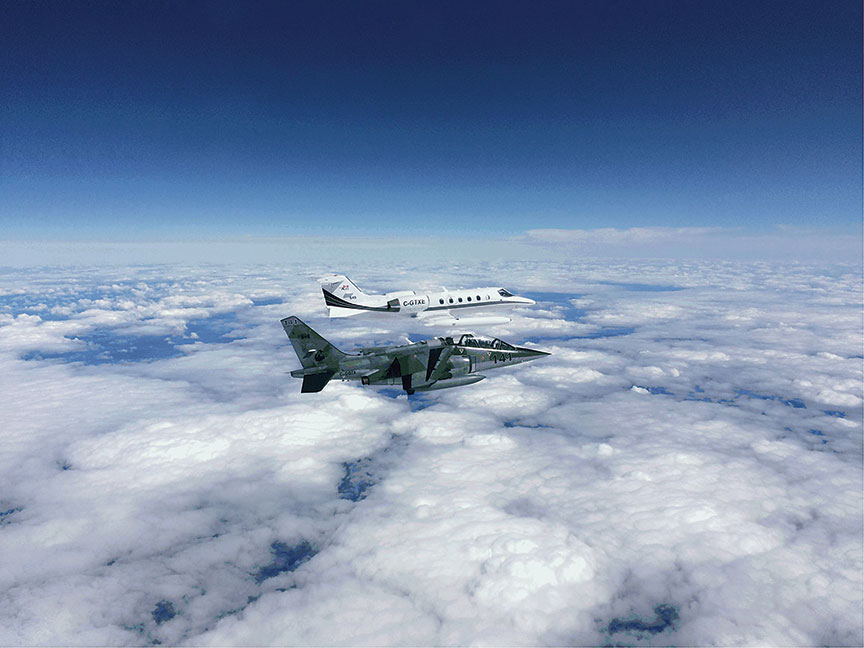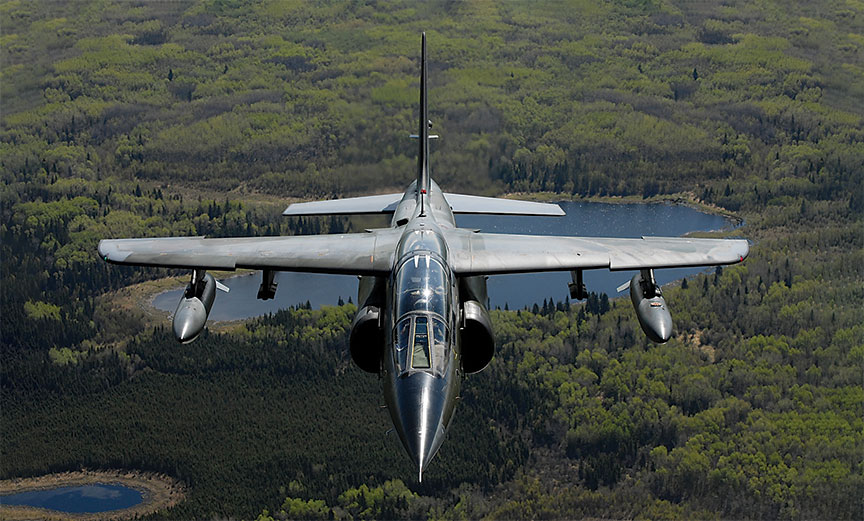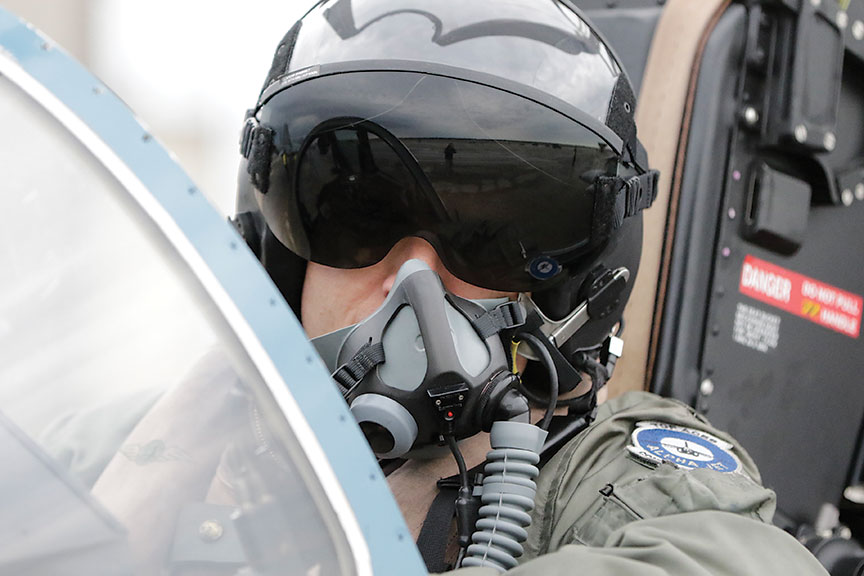Estimated reading time 12 minutes, 47 seconds.
Like many events in the Air Force, being the enemy begins with a briefing. And no, it does not involve scheming how best to defeat Royal Canadian Air Force (RCAF) pilots. It’s a far more collegial confirmation that the ‘red air’ plan for the day will meet the ‘blue force’ training objectives.
After all, even when playing the adversary, aggressor pilots are still instructors, observed Kareen “Handles” Mamo.

A former CF-188 Hornet pilot with a combat tour in 2015 over Iraq, she served 20 years in the RCAF, with both 433 and 425 Tactical Fighter Squadrons at 3 Wing Bagotville, Que. A Fighter Weapons Instructor Course (FWIC) graduate, the Canadian equivalent of the U.S. Navy’s Top Gun course, Mamo was also an instructor pilot on the course before transitioning to the Reserve in 2017 when she joined Top Aces.
Red air training missions follow a typical routine. They often begin the day before with a conversation with the blue force leader to understand the exercise intent and the threats to be replicated. The red air lead will then develop a game plan, essentially the lines they will fly as the enemy force. Before the mission itself, that blue air pilot will conduct a coordination briefing that includes training objectives, special instructions for the adversary unit, and weather information.
Often, however, that plan gets adapted on the fly.
“This is where I find our experience benefits us,” said Mamo. “Sometimes the briefed plan may have to flex. As the red lead, we’ll have to amend it airborne to help with the blue training objectives.”
On a mid-August morning in Bagotville, for instance, she led an aggressor mission in support of an RCAF pilot obtaining an upgrade. Because the pilot was required to face a radar threat and her Dornier Alpha Jet cannot replicate that, she was also assigned a new combat wingman flying a CF-188 as the “radar shooter.” While the upgrade flight went to plan, once it was completed, her newly minted wingman asked for some additional NORAD mission-related training. She promptly switched from a red air threat to a NORAD platform and provided pilot intercept opportunities.

The instinct to teach is never far removed for former instructor pilots.
“If I have an opportunity at the end of a brief to help out an inexperienced pilot or help provide a couple points that they didn’t see that can improve safety or the effectiveness of their next trip, that is something I like to do,” Mamo said. “I like to see us as a force multiplier.”
As the adversary at the coordination briefing and/or post-mission debrief, however, red air pilots are judicious about when they step forward and what they say, explained James “Preston” Manning, Top Aces’ vice president and a former CF-188 pilot with over two decades and 3,000 flight hours on the airframe.
“You want them to develop themselves first, and only when it becomes apparent that there is a safety issue do you want to speak up. We tell all of our pilots that they are likely the most experienced guy on this mission, and you have a kind of safety valve role,” said Manning, a FWIC instructor for almost 15 years.
“So, you might put up a hand at the end of the coordination brief and say, ‘Have you thought about this? Because it doesn’t seem like the deconfliction over the target area is adequate.’ Or at the end of the post-mission debrief you might throw in a couple of additional points for consideration that might benefit their formation debrief. We try to find the right balance to better allow their leads to develop as instructors.”
TRAINING FOR ALL MISSIONS
Manning, who transitioned to the Reserve in 2007 when he joined Top Aces and continued as a line pilot until retiring in 2018, is responsible for the Contracted Airborne Training Services (CATS) program in Canada, an innovative 10-year contract awarded in October 2017 to provide adversarial support for Canadian Armed Forces training.

The wide-ranging program includes simulating hostile threats such as fighter bomber and air-to-ship missiles as well as medium altitude and sea skimming target towing for the Royal Canadian Navy; close air support replication for the Canadian Army’s joint terminal attack controllers and simulated air attack for Army air defence training; and regular validation of the North Warning System early-warning radios and radars, a process that involves Arctic flights with a Bombardier Learjet 35A to test their quality and function.
While Air Force support includes some niche activities such as training electronic warfare officers from the cabin of a Learjet, most of the aggressor missions are targeted at the fighter force. And the RCAF demands a lot of its CF-188 pilots. With just four tactical fighter squadrons, Hornet pilots train for every mission, from close air support to NORAD, air interdiction and NATO air policing.
“It’s quite a significant training bill,” Manning noted.
The phased approach builds from basic air-to-ground missions to more complex two-ship, four-ship and multi-formation flying, and “red air gets scaled along with the training objectives,” he explained. “You will start with only one or two aircraft with no electronic attack, then go to two-ship with electronic attack, then four-ship, then a mixed force of radar and non-radar equipped players. Those small missions are somewhat formulaic and straightforward to coordinate and execute. A big flag level exercise might have dozens of aircraft – a mix of Top Aces, RCAF and other allied fighters – and those are far more complex.”
The red air team will tailor its threat level to blue force requirements, so the deconfliction plan becomes increasingly more challenging to script as more assets are integrated, said Mamo. “If you have many aircraft, you have to provide a structured game plan to deconflict and ensure a safe and effective flow in and out.”

In flag exercises, much of the critical information to formulate a plan is readily available. A published scenario and special instructions such as blue and red aircraft coordination details, radio frequencies, and deconfliction lines are made available to all participants well in advance. For day-to-day training at the unit level, that information is often delivered in the coordination brief, about 90 minutes before the training mission, Manning emphasized.
“We rely on the experience of our guys to adapt to that brief, to use standard operating procedures to cover a lot of what is the same everyday so we can focus on what is critical for mission execution – safety and the lines we are going to fly.”
Though the type of red air threat for each exercise is determined by the blue air lead, Top Aces strives to remain current on adversary capabilities, systems and techniques, tactics and procedures. Despite having security clearance, it can be difficult for a commercial company to “access that type of information,” Manning observed, so decades of experience flying the RCAF missions become a decided advantage.
“That’s probably an under-recognized value of the CATS contract,” he said. “It has provided a vehicle to preserve access to highly experienced mentors. We routinely put together a four ship of red air with over 10,000 hours of CF-188 experience – that is decades of fighter experience that the RCAF has invested a lot in developing.”
EVOLVING THE THREAT
The RCAF has been on the leading edge of contracted training support since the CATS approach was first launched on an interim basis in 2005. The blend of military and civilian-supported training under CATS and other pilot development programs has attracted international consideration. Manning credits part of that success to stringent airworthiness standards. Top Aces’ fleets of Alpha Jets, Douglas A-4 Skyhawks and the Learjet must meet both Transport Canada and RCAF airworthiness standards that are identical to those of any civilian and military aircraft.
“It is a hard standard to meet, but it is one of the things that has allowed us to [export] our services to Germany and elsewhere,” he said.

While the Alpha Jet has been modified with an electro-optical infrared sensor to replicate the sniper pod of a CF-188 and can integrate night vision systems and drop practice munitions, “it is still a basic aircraft,” Manning emphasized. “When we do threat replication, we can make it more sophisticated with the inclusion of electronic warfare capabilities and jamming pods, but it does not have supersonic speed or the radar of a modern aircraft.”
CATS was designed from the outset to evolve over the life of the contract, particularly as the threat environment changes and the RCAF acquires and employs a next-generation fighter jet. To replicate the threat of a near-peer in a conflict where the Air Force can no longer count on extended periods of air superiority will require a more modern aggressor aircraft.
“CATS is not going to remain static through that transition,” said Manning. “You have to train against that level of threat to be able to operate effectively against it.”
In late 2020, Top Aces formalized an agreement to acquire up to 29 F-16 A/B fighters from Israel and began flying the first this summer at its F-16 Center of Excellence in Mesa, A.Z.
“The beauty of the F-16 is that it offers the kinematics of a sophisticated threat,” said Manning, who has 400 hours in the aircraft as part of an exchange tour with the U.S. Air Force at Cannon Air Force Base, N.M. “It’s got amazing in-close dogfighting performance. With our open architecture advanced aggressor mission system on it, you can integrate new sensors as they evolve. That’s a significant strength. A near-peer threat is what forces are going to want to train against and our goal is to replicate that as close as we can with what is commercially accessible.”
In the near term, that will involve more virtual and constructive red air threats in training missions, but could soon evolve to include unmanned aircraft with payloads able to simulate a range of threats, he added.
DEVELOPING EXCELLENT PILOTS
Representing the enemy may have its routines, but “every day is not the same,” said Mamo. And that is part of what keeps it rewarding. “I have always enjoyed the dynamic nature of it. The [Top Aces and RCAF] people you fly with make it great.”

The stability of living and working in Bagotville is also a plus. With two children and a husband who is also a former fighter pilot and now works for Top Aces, “this is a welcome change” from the regular postings of the military.
More than anything, it’s the ability to keep flying and instructing, said Manning. “The single thing I found the most rewarding in my Hornet career was helping in the development of excellent fighter pilots, seeing them grow from a new guy on the squadron who didn’t know what was going on, to seeing them graduate as a fighter weapons instructor. It was gratifying to know you had played a small part in that person’s development. In a sense, we get to continue that in a less direct role.”

Great article. I see Top Aces Alpha Jets operating out of Winnipeg fairly regularly. They are doing an excellent job!